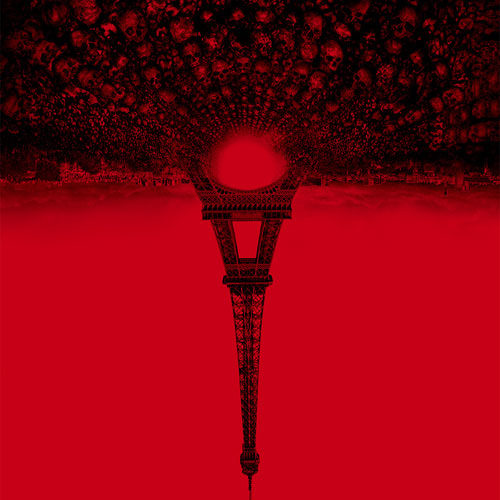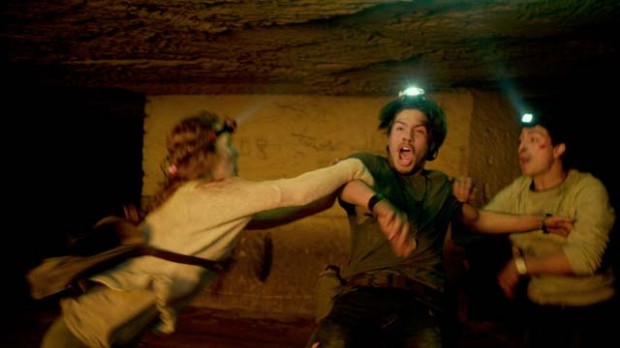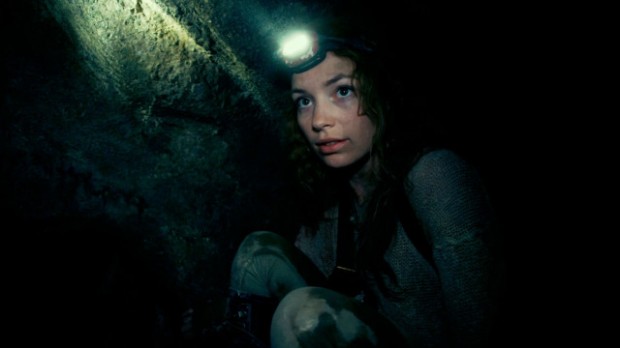Although incantations and intimations of the arcane spring to mind when considering the title of the new Brothers Dowdle thriller As Above, So Below, the film’s ominous moniker teases something more psychologically interesting and esoteric underneath it’s earthy skin-and-bones. The movie is set and filmed within the Catacombs of Paris, underground ossuaries that make up the scariest location for a horror movie this side of a booth in Denny’s at 2 am. Adopting the stale and blasé format of found footage, the Dowdles attempt a multi-layered merger of genres and tones, culminating in a final product that is sometimes refreshingly versatile, but more often-than-not, frustratingly goofy.
Half of As Above plays like a modern, wide-eyed archeological adventure—hinting at the ghosts of a historical past evaporated from the imagination of the social media culture—with a mostly stock cast of characters playing interlopers to a hidden kingdom of the dead. The other half–let’s call it the So Below part—is a slow-burn, atmospherically dank horror thriller that teases out human frailty and internal regret, but relies so excessively on supernatural set-pieces that it starts to play like a crazed French art installation. When each corner of the admittedly spooky catacombs reveals decrepit Templar Knights, burning car wrecks, and the strangest choir this side of a Bonnie Tyler video, the film’s harrowing sense of eternal damnation transforms into eye-rolling exasperation. One half expects Vincent Cassel, decked out in a latex devil suit, to come traipsing out behind the wall of skulls playing a violin.
Despite its collapse in the second half, As Above, So Below can be commended for being more ambitious than your average found-footage August horror flick; it has an exciting tone, an admirable intent, and plenty of claustrophobic atmosphere. The acting, such as it is, is serviceable for the material, with particular credit going to Perdita Weeks as fabulously (and implausibly dressed) adventuress, Scarlett Marlowe, hunting lost treasures as a way to defeat the demons of regret tied to her dearly departed father. Marlowe, in the wake of dad’s mental illness and eventual suicide, is on a quest for the same fabled relic he was searching for; the Philosopher Stone of Nicholas Flamel (yes, the same one Harry Potter had to contend with). That quest lands Marlowe, ex-boyfriend George (Ben Feldman), cameraman Benji (Edwin Hodge), and a gaggle of Parisian guides, smack in the middle of those catacombs, trapped behind a boulder collapse and faced with the familiar inscription; “Abandon all hope, ye who enter here.” This is that kind of movie where the obsessed scholar fails to recognize Dante, but has no issue blabbing on about every useless expeditionary snafu along the way.
When the Dowdles made Devil in 2012, they demonstrated a sure-hand at finding the surreal and enigmatic in microcosmic banality. That film was awash in low-key creepiness masked by the ordinary. The lost souls trapped in the elevator were caught-up in a limbo defined by canted, confining angles and suffocating, suspicious close-ups, a reality juxtaposed in unnervingly strange opening credits that presented the skyline of Philadelphia upside-down. That floating world of submerged cathedral tops and diving skyscrapers signaled entry into lands foreign to normal logic, not unlike Rod Serling’s introductory narrations on The Twilight Zone. In As Above, the setting itself is front-loaded with dread and mythical significance and the Dowdles keep their camera focused and confined to the passage ahead. At first, it seems they have retreated to tiring spook-show theatrics, but slowly reveal that the interior horrors of their protagonists’ psyche are being exposed on the broken cemetery ruins around them.
When the natural, innate dread of this subterranean pilgrimage is being exploited by the camera and effective, minimalistic sound design, As Above develops some of the same primal disquiet that made Neil Marshall’s The Descent such a powerhouse of fright. As long as that suspense and tension is being focused on the immediate fears of the characters and the morbid geography of their ancient prison, the film mostly works as a shivery, beguiling trinket. When The Descent revealed itself as a monster movie, Marshall also ramped up the emotional and physical tensions of his gang of cave-spelunking gals; As Above wants to burrow deeper psychologically, but only ends up with a kind of carnival funhouse tinged with religious iconography. When each explorer comes face to face with their hidden guilt in the form of some ghoulish set piece, the movie feels more tired than fresh. It doesn’t help that the script starts generating tiresome in-fighting that only exists to slow and mire the travelers from their intended escape.
The fact also remains that As Above, So Below need not be found footage. This particular gimmick is well-handled, but it closes off the opportunities that do abound in this wonderful location. The catacombs themselves should come off as their own character in the film, but outside of some initial flavor, we never get a true sense of them as the historical oddity they are; they eventually transform into one more generic horror trope used to wring a little more tension out of the obvious scares. Although it starts as a fine, creepy endeavor, As Above gets lost down in the dark with its characters, rendering Dante’s iconic warning equally relevant to an audience looking for original frights. Abandon all hope, indeed.
As Above, So Below is now playing in wide release.



